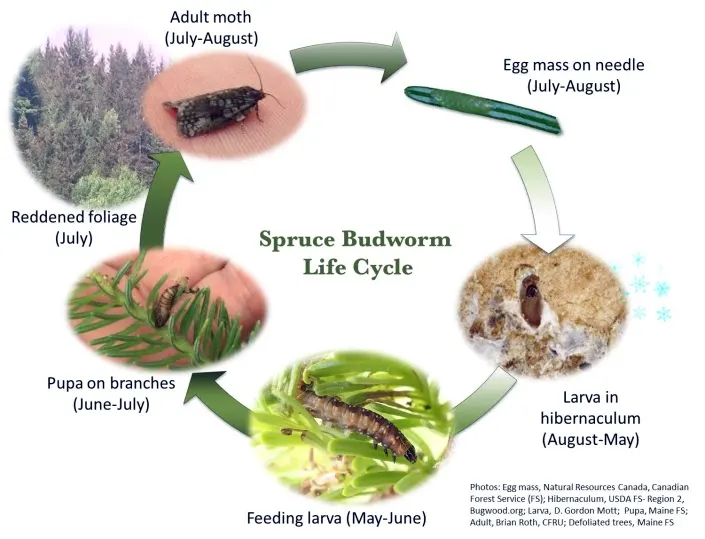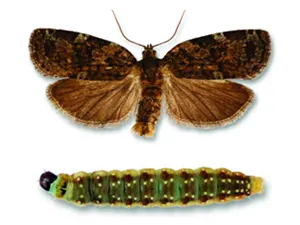HOST PLANTS:
Balsam Fir and White Spruce. To a lesser extent on Red Spruce and Black Spruce. ![]()
DAMAGE:
The spruce budworm has a significant impact on Canada’s forests.
- Spruce budworm damage appears in May.
- Evidence of a spruce budworm infestation includes the destruction of buds, defoliation of current-year shoots and, if an affected branch is disturbed, the presence of large numbers of larvae suspended from strands of silk.
- Defoliation begins at the top of the tree and current-year needles are partially or completely consumed. If large numbers of larvae are present, previous-year needles may also be affected. Spruce budworm larvae also feed on staminate (male) flowers and cones. During epidemics, the larvae may destroy all of the cones.
- Severely affected tree stands turn a rust colour due to the presence of dried-out needles held together by strands of silk spun by the larvae. In the fall, most dead needles are dispersed by the wind and defoliated stands take on a greyish appearance.
- A single year of defoliation may little impact on the tree, however, it does cause weakening of the tree, making it more susceptible to attacks by other insects.
- Cumulative defoliation can cause significant mortality and growth loss in mature spruce-fir forests; resulting in significant losses of important timber and non-timber resources.
DESCRIPTION AND LIFESTYLE:
The (eastern) spruce budworm (Choristoneura fumiferana) is a moth native to North America. Spruce budworm feeds mainly on balsam fir and white spruce, and to a lesser extent on red spruce and black spruce. Trees usually die after four or five consecutive years of severe defoliation.
Lifecycle
- Adult moths mate and lay eggs in clusters of 10-150 on the needles of host trees in July and August.
- Newly hatched larvae spin cocoons in protected areas on the host tree where they spend the winter.
- In the spring, larvae emerge and start feeding on new foliage using the needles to build a silken shelter to protect themselves from predators.
- Defoliation becomes visually noticeable in late June when larvae have completed most of their feeding.
- Budworm moths emerge from pupae in July/August and lay eggs on
the foliage to complete their life cycle.

Additional Facts
- Outbreak cycles of spruce budworm occur every 30 to 40 years.
- During an outbreak, tens of millions of hectares of trees can be severely defoliated. An outbreak may last several years.
- The most recent outbreak started in Quebec on the north shore of the St. Lawrence River in 2006, with about 3,000 hectares being defoliated.
- By 2019, over 9.6 million hectares of forest in Quebec has suffered moderate to severe defoliation.
- In western Canada, outbreaks of spruce budworm occur intermittently at the edge of its range in northern boreal forests from Manitoba through the Yukon.
CONTROL MEASURES:
Various insecticides are used against the spruce budworm to protect valuable spruce and fir trees. Large-scale chemical and biological control operations are carried out aerially in various parts of Canada to reduce tree mortality. Currently, registered products to control spruce budworm in commercial aerial operations include the biological insecticide Bacillus thuringiensis (Bt), a naturally occurring bacterium, and Tebutinozide (Mimic), a growth regulator hormone.
Ground spray equipment is often used when spraying ornamentals around the home or cottage. Currently, registered products for domestic use include malathion, carbaryl, dimethoate, permethrin, acephate, aminocarb, trichlorfon and Bacillus thuringiensis.
Insecticides are applied when larval development has reached third to fourth instar (approximately six to 10 mm in length), in synchrony with the elongation and flaring open of current shoots. At this point, larvae are exposed and vulnerable to the insecticide. Successful application controls the larvae before they reach the fifth and sixth instars, when the majority of feeding takes place.



Source: Government of Canada https://natural-resources.canada.ca/our-natural-resources/forests/wildland-fires-insectsdisturbances/
top-forest-insects-and-diseases-canada/spruce-budworm/13383 Source: Province of Manitoba https://www.gov.mb.ca/nrnd/forest/pubs/forest_lands/health/spruce_budworm_brochure.pdf
